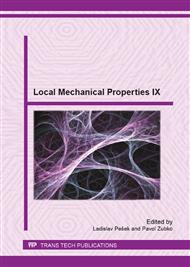p.15
p.19
p.23
p.27
p.31
p.35
p.39
p.43
p.47
Effect of Crystallographic Orientation on Hardness and Indentation Modulus in Austenitic Stainless Steel
Abstract:
The most commonly used method for the analysis of instrumented indentation test (Oliver-Pharr) is based on isotropic elastic solution of contact problem which is not necessarily valid when indenting at the scale of one (anisotropic) grain. In this paper, we performed the grid indentation method at the sub-micron scale (at low indentation load and depth of penetration) on an area containing several grains with different crystallographic orientation which was simultaneously characterized by electron back-scattered diffraction. Measured dependencies of hardness and indentation modulus on crystallographic orientation were compared with analytical solution and finite element simulations.
Info:
Periodical:
Pages:
31-34
Citation:
Online since:
September 2013
Authors:
Price:
Сopyright:
© 2014 Trans Tech Publications Ltd. All Rights Reserved
Share:
Citation:


